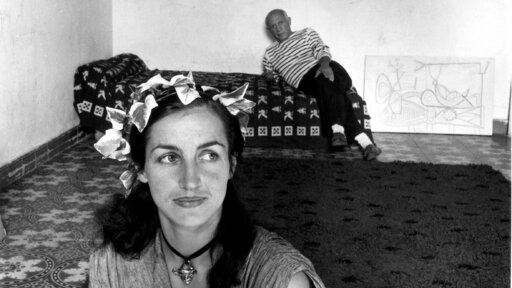On surviving Picasso – Alan Riding in NYT:
‘Françoise Gilot, an accomplished painter whose art was eclipsed by her long and stormy romantic relationship with a much older Pablo Picasso, and who alone among his many mistresses walked out on him, died on Tuesday at a hospital in Manhattan. She was 101.’
(…)
‘In 1970, she married Jonas Salk, the American medical researcher who developed the first safe polio vaccine, and lived part of the time in California. Still, it was for her romance with Picasso that the public knew her best, particularly after her memoir, “Life with Picasso,” written with Carlton Lake, was published in 1964. It became an international best seller, and so infuriated Picasso that he broke off all contact with Ms. Gilot and their two children, Claude and Paloma Picasso.’
(…)
‘If Ms. Gilot’s book sold well, so has her art. With her work in more than a dozen museums, including the Metropolitan Museum of Art and the Museum of Modern Art in New York and the Centre Pompidou in Paris, her paintings fetched increasingly higher prices well into her later years.
As recently as June 2021, her painting “Paloma à la Guitare” (1965), a blue-toned portrait of her daughter, sold for $1.3 million in an online auction by Sotheby’s. That surpassed her previous record price, $695,000, paid for “Étude bleue,” a 1953 portrait of a seated woman, at a Sotheby’s auction in 2014. And in November 2021, her abstract 1977 canvas “Living Forest” sold for $1.3 million as part of a retrospective of her work at Christie’s in Hong Kong.’
(…)
‘She continued her law studies at the University of Paris, but after taking her second-year examinations, in June 1941, she lost interest and abandoned the field, deciding to devote herself to art. She began private lessons with a fugitive Hungarian Jewish painter, Endre Rozsda, and attended classes at the Académie Julian, which numbered Matisse, Bonnard, Léger and Duchamp among its alumni. Her father was unhappy about the decision, however, and the two clashed frequently, until Ms. Gilot moved in with her grandmother.
As Ms. Gilot described it in “Life With Picasso,” her first encounter with Picasso, in May 1943, was accidental. She was dining with her closest friend, Geneviève Aliquot, and an actor, Alain Cuny, in Le Catalan, a small restaurant on the rue des Grands-Augustins, near Picasso’s Left Bank studio. Picasso was at another table accompanied by his mistress at the time, the Surrealist photographer Dora Maar.’
(…)
‘She spent much of that summer with Geneviève in Provence. But in the winter of 1944 her relationship with Picasso blossomed. She was 22; he was 62. She later recalled lying naked by his side. “He was very gentle,” she wrote, “and that is the impression that remains with me to this day — his extraordinary gentleness.”’
(…)
‘Meanwhile, Dora Maar was still present in his life, as was his longtime mistress Marie-Thérèse Walter. Maar began to worry, rightly, that Ms. Gilot would replace her. Indeed, in May 1946, Ms. Gilot agreed to move in with Picasso, and a volatile chapter in her life began.
By all accounts, while Picasso’s painting and ceramics reflected a new happiness — he portrayed Ms. Gilot as a nymph to his centaur — he apparently now felt that he had conquered her and began seeing other women.
She gave birth to Claude in May 1947 and Paloma in April 1949. She also continued painting, adopting a colorful abstract style associated with the postwar School of Paris rather than imitating Picasso. In April 1952, she had a well received exhibition in Paris. But by then Picasso had been traveling to southern France without her and made little secret of his new affairs.’
(…)
‘Ms. Gilot’s final rupture with the artist was over “Life With Picasso.” His friends attacked her over the memoir, and so did the French Communist Party. Picasso himself made three vain attempts to prevent the book from being published in France. Then he refused to see Claude and Paloma again, apparently keeping his word until his death in 1973.
By then Ms. Gilot had married Jonas Salk, shuttling between a home in the La Jolla section of San Diego and her studio in southern France. In 1975, she published a new book, “Interface: The Painter and the Mask,” a memoir of her life as an artist. The next year she became chairwoman of the fine arts department at the University of Southern California, a post she held until 1983.’
(…)
‘Asked by Ms. La Ferla if she had ever felt competitive with Picasso or his friends — among them Chagall, Braque, Matisse and Giacometti — Ms. Gilot replied: “That never entered my mind. I started painting, after all, at 3 years old. As a child, you aren’t thinking in terms of me, me, me. You are not capable of that.”
But she acknowledged that those 20th century masters had an inevitable impact. They “helped me grow,” she said, and by their very attention instilled in her a measure of self-confidence.
“I realized,” she said, “if they are so great, then I am not so small.”’
Read the article here.
Gentle and less gentle. The case against Picasso has been discussed enough.
In some way he was like the German army, conquer and move on. His Blitzkrieg was more successfully and also – that cannot be repeated enough in these days – gentle. At least sometimes.
